MXA’S 2015 KTM 350SXF MOTOCROSS TEST: NON-ORGANIC WINNER
Q: FIRST AND FOREMOST, IS THE 2015 KTM 350SXF BETTER THAN THE 2014 350SXF?
A: Yes. The 2015 KTM 350SXF is a giant step forward for the mid-size Open bike idea.
Q: WHERE DID THE 350 MOTOCROSS BIKE IDEA GERMINATE FROM?
A: Power politics. The birth of the 350 was not an organic development that was market driven by consumer demand, which makes its success all the more amazing. The original idea was generated by two bureaucrats—Youthstream’s Giuseppe Luongo and the AMA’s Steve Whitelock—who felt that 450cc motocross bikes were too powerful. Their plan, which was doomed from the beginning, was to strong-arm the rule-makers into regulating the maximum engine size down to 350cc. They both used their bully pulpits to proselytize about the nirvana of a 350cc world.
The problem for Luongo and Whitelock’s crusade was that no one at Honda, Yamaha, Suzuki or Kawasaki had any intention of building a 350cc motocross bike. Why not? The bottom line. If a manufacturer was selling 20,000 units, equally divided between 250cc four-strokes and 450cc four-strokes, and it made a 350cc four-stroke, its sales department predicted that sales would not increase by 33 percent but that they would sell the same 20,000 units—only divided into three smaller groups. They would still sell 20,000 units, but the 350 would cannibalize 250cc and 450cc sales to do it. And when they factored in the costs of R&D, castings, marketing, warehousing and promotion of a third model, they saw red ink. If Luongo and Whitelock had tried to force a 350cc max displacement rule on the sport, the “Big Four” would have found someplace else to race. Thus, the 350 idea was dead on arrival.
Q: SO, WHY DID KTM AGREE TO BUILD A 350?
A: There are three reasons why KTM bit when the other fish swam away.
(1) Niche marketing. KTM is a niche marketer. They hit the Big Four where they aren’t. Thus, KTM builds 50cc, 65cc, 85cc, 125cc, 150cc, 200cc, 250cc, 300cc, 350cc, 450cc and 500cc bikes in a variety of forms—motocross, enduro, cross-country and dual sport. Finding niches, special products for special groups, has paid off for KTM, especially as the Japanese manufacturers have cut back drastically on offroad models, engine displacements and engine types (read two-strokes).
(2) Direction. Reportedly, at the time, KTM was working on a new mid-sized enduro engine to replace the discontinued KTM 400. The enduro concept was still in the prototype stage when Luongo and Whitelock began beating the 350 drum, thus KTM was mentally prepared to have a dog in the fight. According to sources, KTM shelved the enduro engine, which was probably in the 380cc region, and instead repurposed the R&D group to work on a 350cc motocross engine that could be used as an enduro engine. KTM didn’t need a shove toward the Luongo/Whitelock foolishness because they were already coasting in that direction anyway.
(3) Bosom buddies. No one can deny that KTM and Youthstream have a very chummy relationship. Whereas the Japanese teams are seen as outsiders, KTM is an insider. While it’s hard to prove that KTM gets favoritism from its close relationship with Luongo, you need look no further than the FIM rule that would have required Jeffrey Herlings to move out of the 250 class after winning his second straight 250 World Championship. With Team KTM already covered in the 450 class by Antonio Cairoli, they didn’t want Herlings to have to leave a sure thing in the 250 class. Surprise! The rule was dropped. This “you scratch my back, I’ll scratch yours” relationship often works in KTM’s favor on the Grand Prix circuit.
Q: WERE THE BIG FOUR WRONG NOT TO EMBRACE THE 350 IDEA?
A: Who knows? The 350 idea was hatched at the beginning of the economic recession—a time when motorcycle sales in the USA fell 650,000 units. Introducing a new model in a climate where bikes weren’t selling was considered marketing suicide. Instead, the Big Four turned turtle and tried to ride out the motorcycle slump by doing nothing more than necessary.
KTM, however, didn’t stick its head in the sand; it invested in new products, engines and designs and actually grew during the recession while everyone else shrank. And, the KTM 350SXF was the star of the KTM hit parade, becoming KTM’s best-selling engine size. KTM has kept fueling its R&D department—and that includes funding the 2015 350SXF (and will even expand again to the 2016 KTM 350SXF).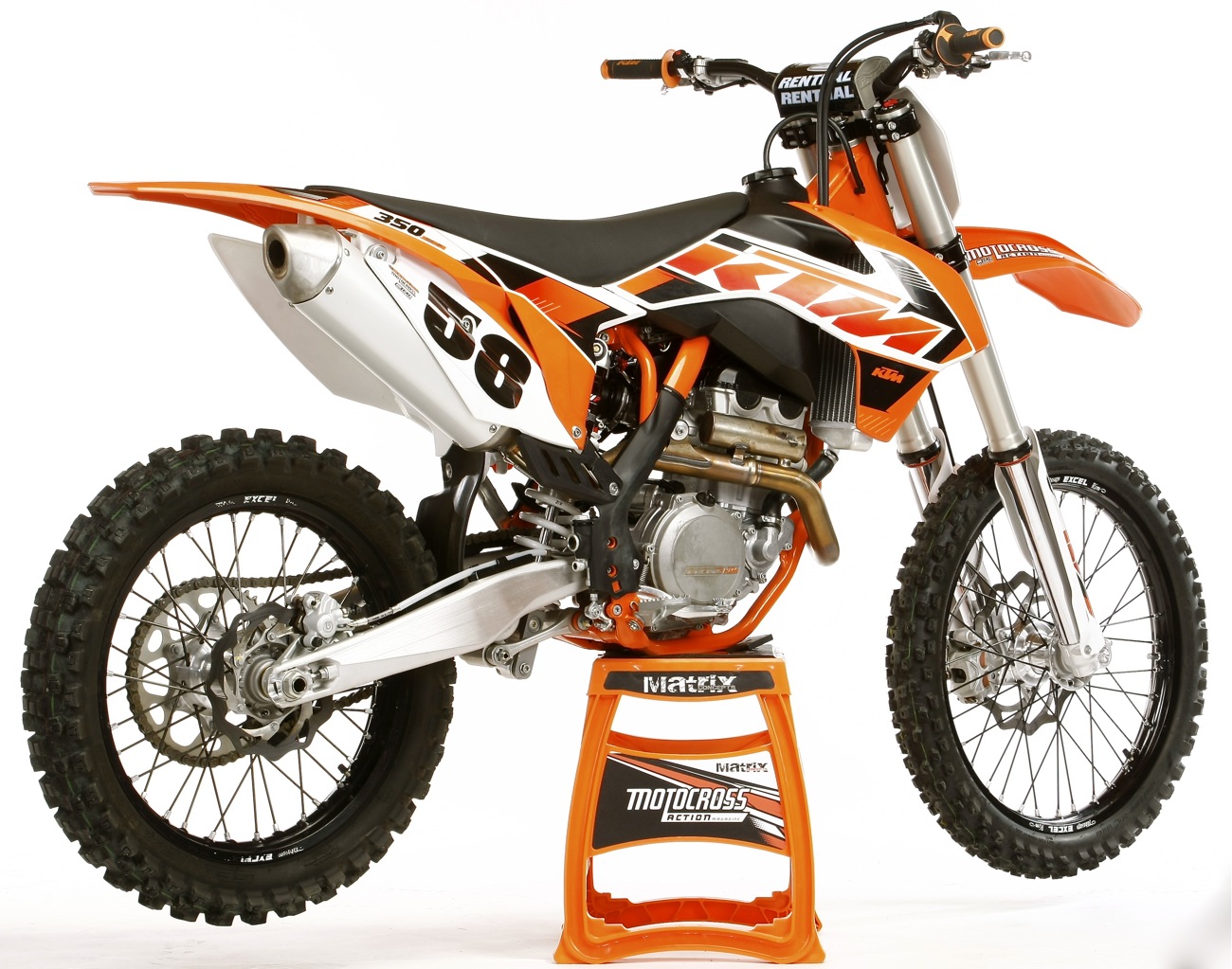
Q: WHAT CHANGES DID KTM MAKE TO THE 2015 350SXF?
A: KTM made 10 major changes to the 2015 models.
(1) 4CS forks. The 2015 KTM 350SXF gets all-new 4CS forks. The new fork is 6.5 ounces lighter than the old WP bladder fork, which will still be OEM equipment on European models, and a totally unique design.
(2) Fork guards. The 2015 fork guards are now an open design and do not wrap around like previous KTM fork guards (and the old-style fork guards will not fit on the 4CS forks).
(3) Fork offset. The front-axle offset has been changed at the fork lugs by moving the axle 2mm rearward (from 35mm in front of the fork center line to 33mm in front). This change required a switch from last year’s 25mm front axle to a smaller 20mm axle (saving 40 grams) to fit in the reduced space of the axle lug.
(4) Rear suspension. The rising rate has been changed via an all-new bell crank and 2.5mm-longer pull rod. The rising-rate curve is stiffer initially, and then flattens out to provide a less progressive curve at the end of the stroke.
(5) Frame cross tube. The cross tube that the shock linkage mounts to has been changed from a tube with welded-on brackets to a one-piece forged cross tube for more rigidity.
(6) Frame color. The frame is now powdercoated orange to mimic the factory race bikes (and the Factory Edition III). If you want to paint your 2014 KTM frame orange, the correct powdercoat color code is RAL2009.
(7) Oil-pump O-rings. The oil-pump suction screen gets new O-rings to help it seal better against impurities.
(8) Triple clamp. The black-anodized triple clamps remain unchanged, but get a new O-ring support for the bottom steering-stem bearing. The steering-stem bolt now has a 17mm hex head instead of the previous 27mm hex. Between the new steering-stem bolt and O-ring bearing support, the triple clamps are approximately 1 ounce lighter.
(9) Wheels. The suspect rims of the last four years have been replaced by what KTM promises are true-to-life black-anodized Excel rims. The spokes are silver; they were black in the past. Every KTM will be equipped with Dunlop Geomax MX52 tires front and rear.
(10) Grips. The dual-compound grips have a softer density for a more comfortable feel.
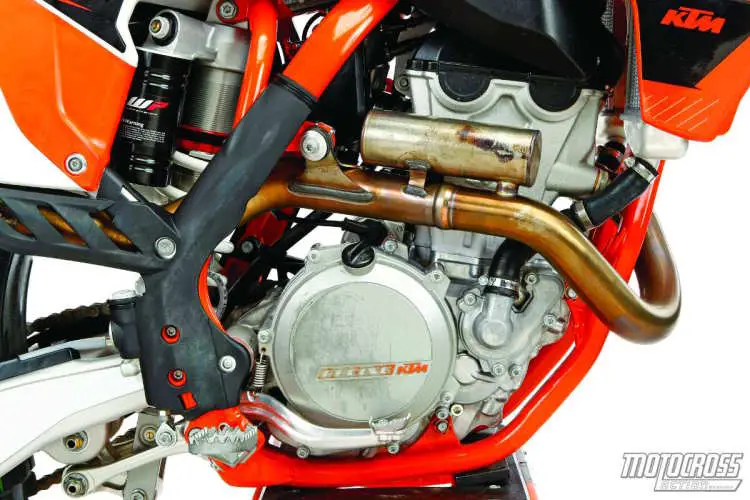
Q: WHAT DID KTM CHANGE ON THE 2015 ENGINE?
A: Nothing. Nada. Zero. Zip. Squat. With the exception of some new clutch springs and an oil seal, the 2015 350SXF engine is the same as the 2014 engine.
Q: HOW GOOD IS THE 2015 KTM 350SXF’S POWERBAND?
A: Good overall power and unlimited revs make the KTM 350SXF very easy to ride. Because it doesn’t make much horsepower in the lower and middle ranges of the powerband, it is very pleasant to ride. But, if you want to go fast, you aren’t going to achieve this by riding around at 10,000 rpm. No siree! Going fast means holding it wide open. The best power is found between 11,000 rpm and 13,400 rpm (with peak power neatly located at 12,600 rpm). That is way up there. If you don’t rev it, you might as well not ride it.
Q: HOW MUCH HORSEPOWER DOES IT MAKE?
A: How much power is kind of a moot point if you aren’t willing to resist shifting long enough to get to where it is. The 2015 KTM 350SXF makes 54.18 horsepower at 12,600 rpm. Don’t get too enamored by the 54.18 horsepower. Yes, it exists, but on the way to making that horsepower, a KTM 450SXF will make 7 more horsepower at 6000 rpm, 8 more horsepower at 7000 rpm, 8 more horsepower at 8000 rpm, 5-1/2 more horsepower at 9000 rpm and 3 horsepower more at 10,000 rpm. It isn’t until the 450SXF signs off at 11,000 rpm that the KTM 350SXF catches and passes it.
For clarification, peak horsepower on the KTM 450SXF is at 9100 rpm, while peak power on the 350SXF is at 12,600 rpm. Think of it as a 54-horsepower open bike that you ride like a 40-horsepower 250.

Q: IS THIS A GOOD ENGINE?
A: It is a great engine—if your mindset is to ride it hard and put it away wet. This is surprising, because many 350SXF riders like the engine because it is so easy to ride in the midrange. No mystery here; it is easy to ride in the midrange because it’s slow in the midrange.
Q: HOW GOOD ARE THE 4CS FORKS?
A: In the 2014 KTM 350SXF test we said, “Suspension is like Kryptonite to KTMs.” We don’t take that statement back, but the new 4CS forks breathe some fresh air into the design and have more potential than the old bladder fork, but they still glow a menacing green in Earth’s sun.
Q: WHAT ABOUT THE NEW RISING RATE?
A: Historically, KTMs have been hard to get to work across the full spectrum of a racetrack. If you set the shock up to be supple in the choppy bumps, you risked it bottoming in the big stuff—and vice versa. Perhaps the new rising rate, which starts stiff and then flattens out, could have been a tad more progressive at the end of the stroke (since we still have the occasional G-out issue), but, overall, the 2015 rear shock is very workmanlike. It should be noted that the 2016 KTM’s will have a different rising rate.
Q: HOW DOES THE 2015 KTM 350SXF HANDLE?
A: This bike sails around a motocross track like a slot car. The key to getting the chassis dialed in is to spend extra time getting the rear sag and front fork height balanced for your weight and style. Once you find the sweet spot, you can make the 250SXF turn corners just by thinking about it. We love the way the KTM 350SXF handles. Part of the charm of the 350SXF’s handling, when compared to a 450, is that there is a lot less rotating mass throwing a monkey wrench into the chassis in roll, yaw and pitch. Less gyroscopic effect from the cams, crank, piston and valves means a bike that feels lighter—even if it isn’t.
Q: CAN YOU HOLESHOT ON A 350SXF?
A: Yes. In a field of 450cc competitors, the 350SXF may give up a boatload of grunt to its bigger brethren, but it has two aces in the hole:
(1) It revs to 13,400 rpm, which plays out as a couple thousand more rpm between shifts. Plus, the higher it revs, the more power it makes—and there is virtually no sign-off on top.
(2) Think of the mellow low-to-mid transition as built-in launch control. It hooks up without the fuss of a 450 and then uses beaucoup rpm to get the job done. Does that mean it will holeshot every moto it’s in? Heavens to Murgatroyd no—just that it has the potential.
Q: WHAT DID WE HATE?
A: The hate list:
(1) Air-filter cage. Without an added dose of due diligence, you stand a chance of sucking dirt because of the way the KTM air-filter cage fits in the airbox.
(2) Gearing. If you don’t add one tooth to the rear sprocket, you will never get full use out of the high-rpm powerband.
(3) Weight. The point of a mid-sized open bike is to complement the modestly powerful engine with a supremely light and agile chassis. The KTM 350SXF may be agile, but it definitely isn’t light. KTM shaved over a pound off for 2015, but they need to lose at least eight more to fit in the prom gown.
(4) Shift lever. The shift lever is either too high or too low.
(5) Frame guards. Putting black frame guards on the new orange frame kind of defeats the purpose of painting the frame in the first place.
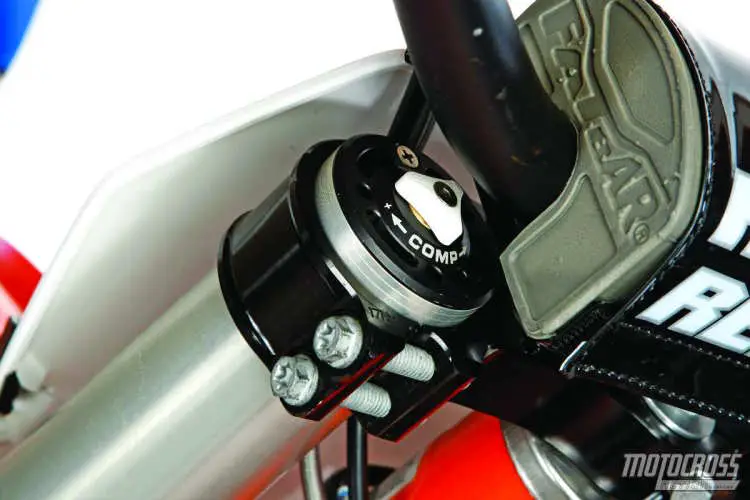
Q: WHAT DID WE LIKE?
A: The like list:
(1) Clutch. This is the way a clutch should work. Good feel, hydraulic power, self-adjusting and long-lasting reliability—even in the hands of an abuser.
(2) Electric start. The greatest idea in offroad riding.
(3) Brakes. KTM’s 260mm Brembo front brake is still the best in the biz.
(4) Handling. Once you get the suspension balanced, this bike carves like a Ginsu knife. Do they have those in Austria?
(5) 4CS forks. They need at least another year of R&D seasoning before they will be ready for prime time.
Q: WHAT DO WE REALLY THINK?
A: The 2015 KTM 350SXF isn’t for everyone. It is an acquired taste. It is the perfect bike for the connoisseur looking for a bike that is more powerful than a 250 but not as brutish as a 450, a bike with a dash of panache instead of being overpowering, and a bike that is easier to ride on the difficult parts of the track—even if that means you have to ride it harder on the easy parts.
It’s not a great Pro bike, which means we are ignoring Tony Cairoli’s supposed 350cc engine, but it is a very good machine for Novices, Intermediates (especially those coming off of a 250) and Vets. And, of course, it will remain the number one choice in the Professional Practice Riders Hall of Fame.
MXA KTM 350SXF SETUP SPECS
This is how we set up our KTM 350SXF for racing. We offer it as a guide to help you find your own sweet spot.
4CS FORK SETTINGS
One of the nice things about the WP 4CS fork over the previous bladder fork is that the clickers actually make a difference. This enabled the MXA test riders to make small clicker adjustments that made noticeable differences on the racetrack. When you can feel a damping change, you can zero in on the right direction and amount of change you want much quicker. Unfortunately, we ran out of clicks before we foudn the suppleness that we wanted. As a bonus, oil height and fork springs can be changed with half the drama of the bladder forks.
For hardcore racing, we recommend this fork setup on the 2015 KTM 350SXF (stock specs are in parentheses):
Spring rate: 0.48 Nm
Oil height: We lower the oil height in 5mm increments to take away the initial harshness (100mm stock)
Compression: 20 clicks out (15 out)
Rebound: 14 clicks out (15 out)
Fork leg height: 5mm up
Notes: We knew the forks were too stiff when our AMA National test riders turned the compression clicker out. They always turn it in to make the forks stiffer, while the Vets turn it out to make it softer. The stock setting is way over the top for the average rider and almost Supercross-stiff for fast guys.
WP SHOCK SETTINGS
The rear suspension should feel stiffer, which, thanks to the more progressive rising rate in the first part of the stroke and firmer internal valving,it should be. The KTM 350SXF doesn’t wallow under acceleration. The new shock is 4mm longer than before, but the rear wheel travel doesn’t change because the new shock linkage allows the shock to hang lower. Don’t fiddle too much with the shock until you get the forks dialed in, then move on to the rear of the KTM.
For hardcore racing, we recommend this shock setup for the 2015 KTM 350SXF (stock specs are in parentheses):
Spring rate: 5.7 kg/mm
Race sag: 100mm
Hi-compression: 2 turns out
Lo-compression: 15 clicks out
Rebound: 15 clicks out
Notes: As a rule of thumb, faster test riders stayed near the standard settings, give or take a click or two, while slower test riders clicked the compression and rebound out as much as four clicks. The spring rate from last year is unchanged, and we don’t think that the average 350SXF rider will need a stiffer shock spring—unless he is very heavy or very fast.




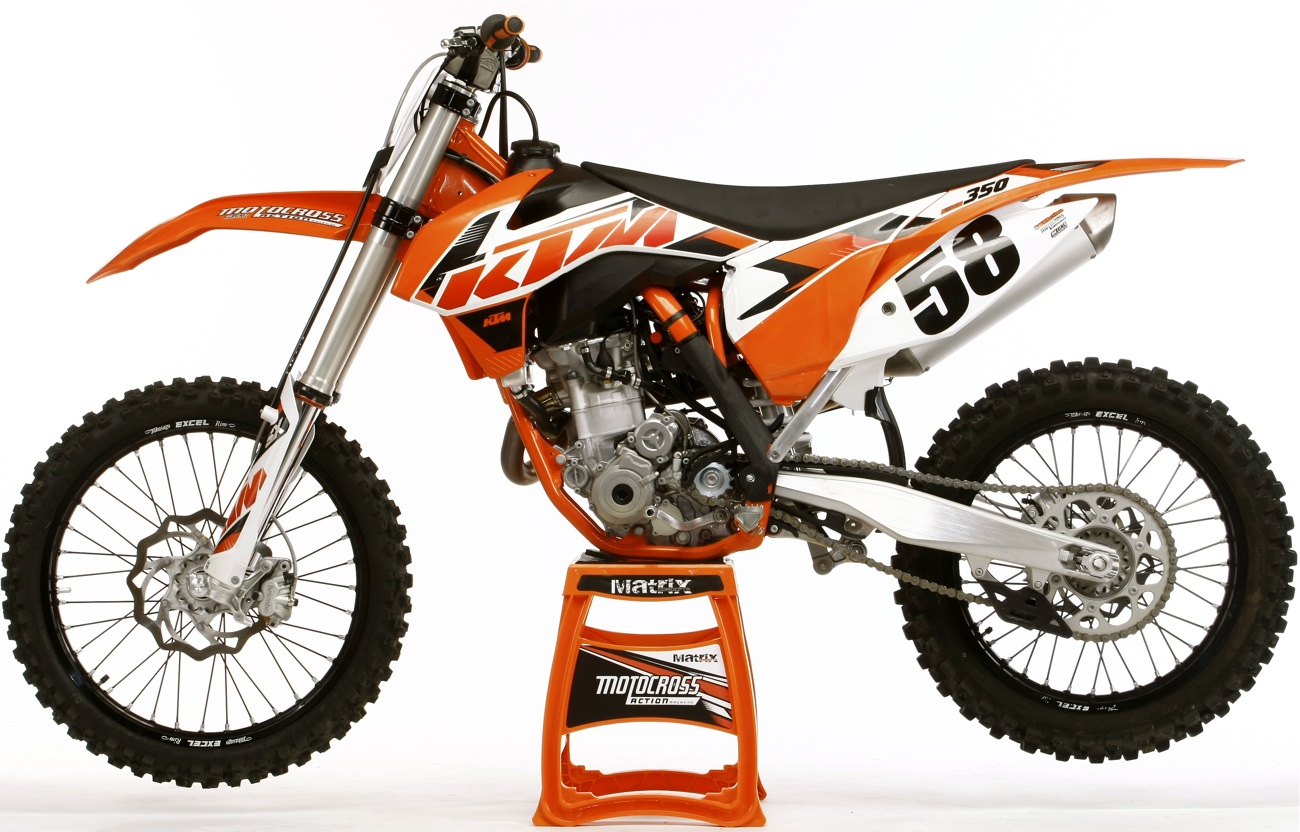


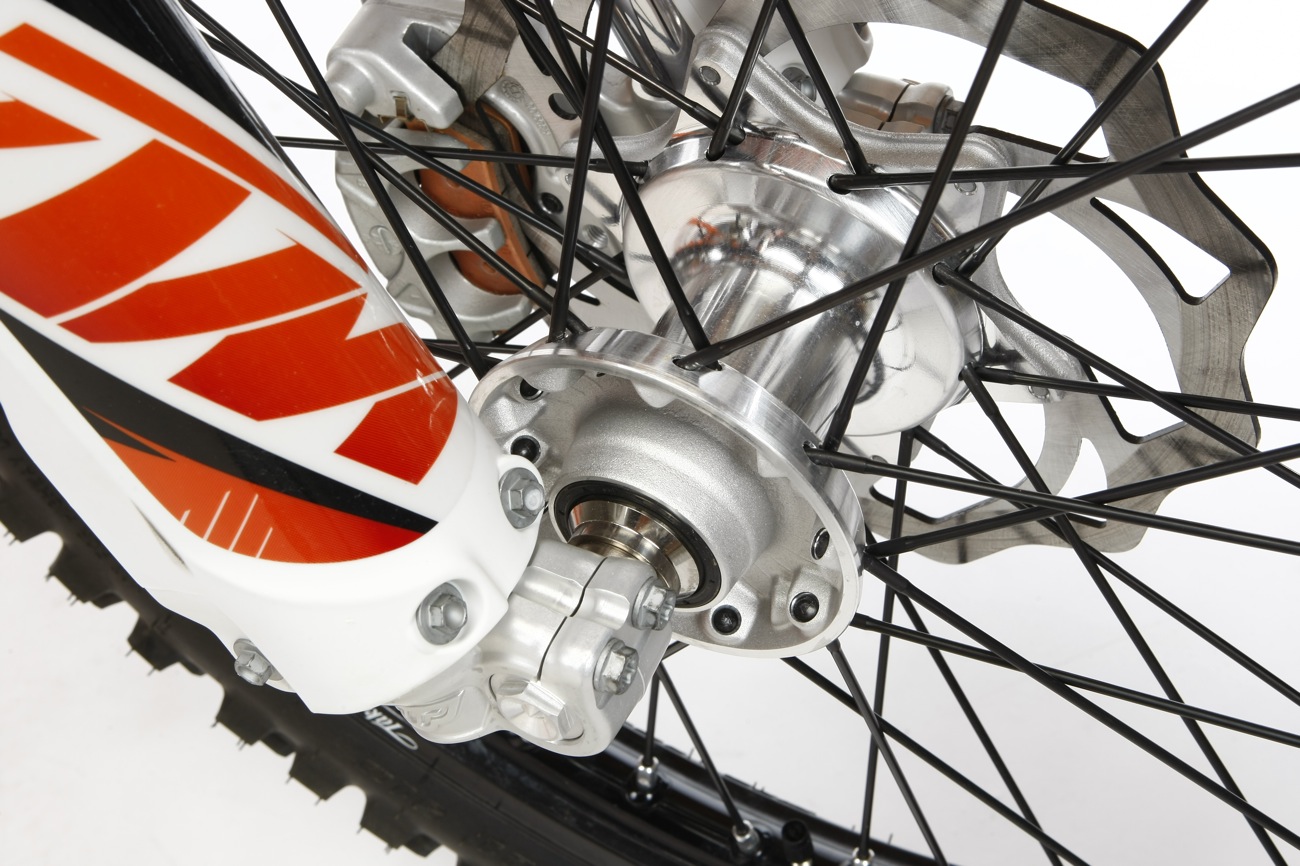

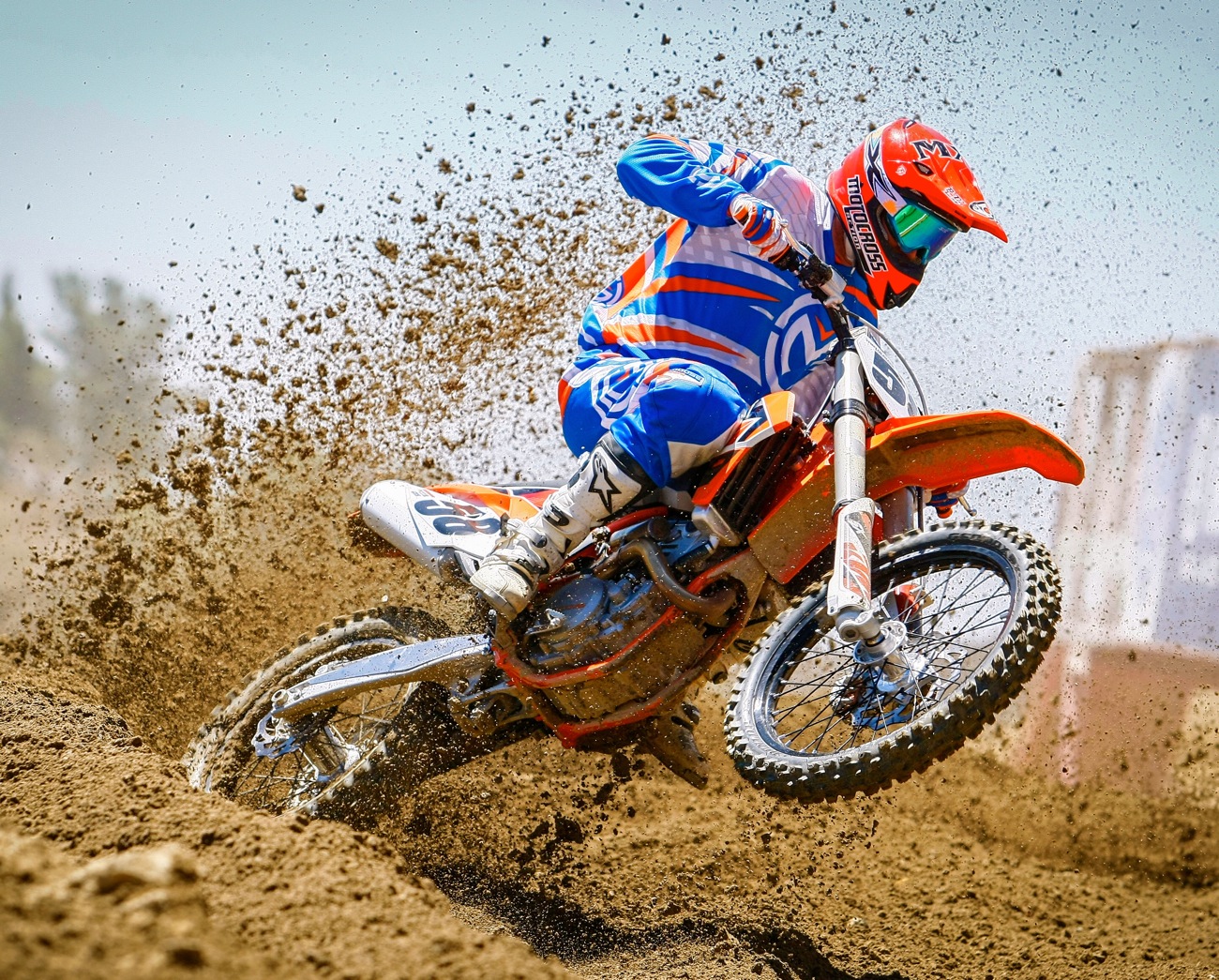



Comments are closed.